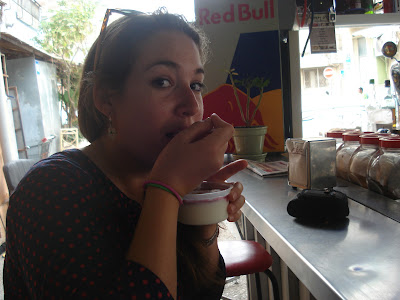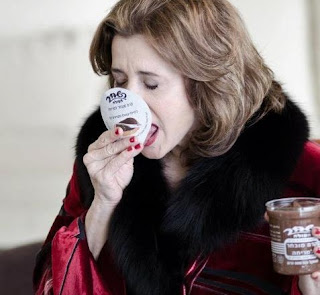 |
| A sampling (right to left) mehchi, harissa, and "donut stick" |
I closed my eyes and took a deep breathe, hoping to stave off the tears that I expected to shed from missing Israel so much that I could still hear its music in my ears. With each breathe I took, the scent of sweet rose syrup, a traditional Middle Eastern ingredient for baked goods, brought me back to my days in Israel. I thought to myself, I must miss that place so much that I can actually hear the harsh and guttural sounds of the Arabic language in my head. When I finally opened my eyes, I found myself in front of an authentic Middle Eastern bakery… in the heart of Paris. The world is certainly shrinking.
This bakery had desserts that I had never come across in all my months in Israel. Mehchi, harissa, and donuts were among some of the few treats I was able to sample. The mehchi consisted of a hard dough shell, filled to the brim with ground almonds and sesame, brown sugar, and cinnamon, covered in a thick rose syrup. The dessert was so sweet that one bite was all I needed before declaring myself full.
 |
| Sweet and dense nut and spice filling |
Unfortunately for my stomach, I always have room for dessert. So I allowed myself another sample from the Parisian-Middle Eastern confectionary. At first glance, this nameless dessert looked like nothing more than a glazed donut stick or carnival gyro. However, like the other desserts I sampled before it, it was incredibly dense, and also quick hard to bite into. The sticky glaze covering it was a sweet syrup made primarily with honey, which oddly enough, was the only ingredient that contributed any sweetness to this dessert. The donut stick itself tasted like nothing more than flour and sesame paste. I suspect it is the equivalent of an Italian biscotti- hard and slightly sweet.
The desserts in this confectionary were obviously Middle Eastern, but incredibly influenced by the Parisian clientele. Which, in this part of the city, happened to be mostly Middle Eastern. Therefore, I can only conclude that candies and desserts have no boundaries. Flavor preferences are no longer determined by the ingredients in that region, but by the people who live there. As the world gets smaller, I wonder if cultural flavors will still exist, and if different tastes will continue to impress others.
























